- This topic has 16 replies, 6 voices, and was last updated 4 years, 11 months ago by
 Robin Leadbeater.
Robin Leadbeater.
-
AuthorPosts
-
30 January 2021 at 2:18 pm #574878
 Robin LeadbeaterParticipant
Robin LeadbeaterParticipantATLAS have announced an interesting transient in a nearby (4Mpc) galaxy NGC 4631.
https://www.wis-tns.org/astronotes/astronote/2021-33
It was discovered yesterday at mag 18.1 which at this distance gives an absolute magnitude of -10. It could be a nova but this would make it at the high luminosity end. It is embedded deep in the galaxy and looking at the discovery image it would be a tough imaging target at the moment and well out of range of amateur spectroscopy but if it turns out to be a supernova on the rise it could get much brighter (a type Ia without extinction would reach mag 9 a this distance !)
EDIT: If it is a supernova caught early it should already be much brighter tonight
Robin
31 January 2021 at 12:14 am #583763 Robin LeadbeaterParticipant
Robin LeadbeaterParticipantThat’s a great shot Nick, particularly with that bright moon. (To much haze here. I could not even see the galaxy) It looks like it probably is a supernova then. It depends on extinction of course which could be high given where it is but this might end up being one of the brightest for quite a while.
31 January 2021 at 12:21 am #583764 Nick JamesParticipant
Nick JamesParticipantHere it is from 2021-01-30T23:46:28 against a very lumpy galaxy background. Astrometry matches the quoted position to within 1 arcsec.
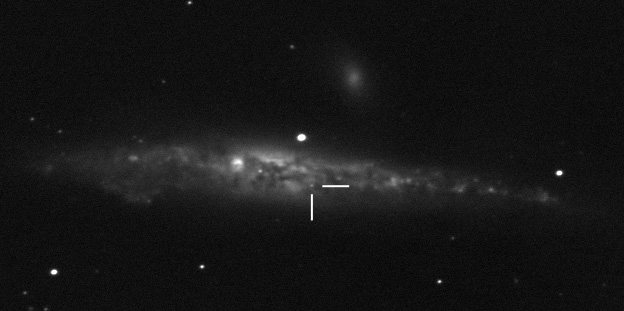 31 January 2021 at 12:27 am #583765
31 January 2021 at 12:27 am #583765 Nick JamesParticipant
Nick JamesParticipantMy original post, which I’ve deleted, marked the wrong object. The new one is correct but has a later timestamp. Robin’s reply hasn’t violated the rules of causality.
31 January 2021 at 12:37 am #583766 Robin LeadbeaterParticipant
Robin LeadbeaterParticipantI thought I was going crazy for a moment there replying to imaginary posts !
1 February 2021 at 12:22 am #583768 Robin LeadbeaterParticipant
Robin LeadbeaterParticipantIt has now been classified as a probable Luminous Red Nova.
http://www.astronomerstelegram.org/?read=14360
I have to confess I had to look up what that was. Fascinating !
https://ui.adsabs.harvard.edu/abs/2019A%26A…630A..75P/abstract
Robin
1 February 2021 at 7:47 am #583769 Nick JamesParticipant
Nick JamesParticipantThat was interesting breakfast reading. The last time I imaged one of these was when V838 Mon erupted 18 years ago. CCDs were much smaller then!
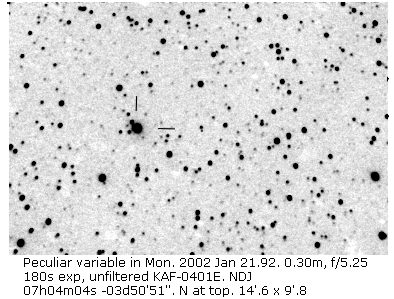 1 February 2021 at 9:38 am #583770
1 February 2021 at 9:38 am #583770 Daryl DobbsParticipant
Daryl DobbsParticipantVery interesting reading, and a good picture, I’ve never heard of this class of nova before. I hope you manage to get a spectra, fascinating class of object.
1 February 2021 at 12:44 pm #583771 Jeremy ShearsParticipant
Jeremy ShearsParticipantRon Arbour has asked me to post this message in his behalf:
The object AT2021 recently discovered in NGC 4631 has been classified as a Luminous Red Variable which is a sub group of Intermediate Luminosity Optical Transients. This group included Intermediate Luminosity Red Transients and intermediate Red Novae among others and bridged the gap between Novae and Supernovae. The first discovery and hence archetype of all these objects was discovered by an amateur and member of the Association, namely myself. A paper on the object was published in the Journal.
J.Br.Astron.Assoc. 126, 3, 2016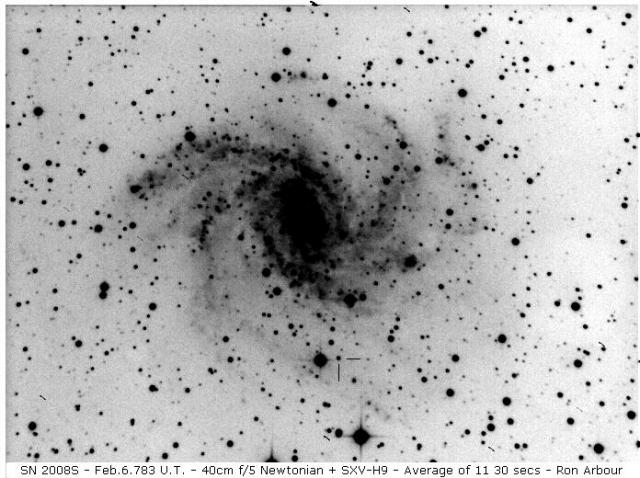 1 February 2021 at 3:26 pm #583772
1 February 2021 at 3:26 pm #583772 Robin LeadbeaterParticipant
Robin LeadbeaterParticipantI remember imaging that with my modified webcam and CCTV camera
http://www.threehillsobservatory.co.uk/astro/astro_image_37.htm
and the spectacular light echo images from the Hubble. I took over where the Hubble left off 🙂
http://www.threehillsobservatory.co.uk/astro/v838Mon_anim.gif
1 February 2021 at 6:07 pm #583775 Nick JamesParticipant
Nick JamesParticipantReally nice animation although I can see the difference between Hubble and your setup…
1 February 2021 at 6:10 pm #583776 Nick JamesParticipant
Nick JamesParticipantYes, a very impressive achievement from Ron.
5 February 2021 at 1:26 am #583792 Peter TicknerParticipant
Peter TicknerParticipantI took this colur image last night in fairly average conditions – in my image it has a blueish tint of a typical supernova.
Peter
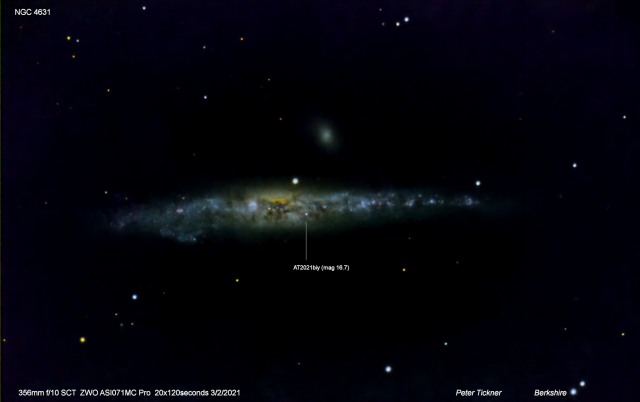 6 February 2021 at 1:52 pm #583799
6 February 2021 at 1:52 pm #583799 Ron ArbourParticipantFor clarification, the object designated AT2021biy has not been classified as a supernova but rather a Luminous Red Nova or Luminous Blue variable:The response to my communication with Andrea Pastorello, one of the authours, is as follows:“This is surely NOT a supernova.I’m not sure 100% it is a LRN or an LBV-outburst, we need to follow it to precisely classify it.It is called *red* because it becomes red (cold) very rapidly, much more rapidly than most transient types, and will reach a mid-M stellar spectral typeafter a few months”.I hope this clarifies why the object appears blue, well shown in Peter Tickner’s excellent colour image. It would be nice to see an image when the object eventually turns red. However that may be very difficult as it could be quite faint.6 February 2021 at 2:55 pm #583800
Ron ArbourParticipantFor clarification, the object designated AT2021biy has not been classified as a supernova but rather a Luminous Red Nova or Luminous Blue variable:The response to my communication with Andrea Pastorello, one of the authours, is as follows:“This is surely NOT a supernova.I’m not sure 100% it is a LRN or an LBV-outburst, we need to follow it to precisely classify it.It is called *red* because it becomes red (cold) very rapidly, much more rapidly than most transient types, and will reach a mid-M stellar spectral typeafter a few months”.I hope this clarifies why the object appears blue, well shown in Peter Tickner’s excellent colour image. It would be nice to see an image when the object eventually turns red. However that may be very difficult as it could be quite faint.6 February 2021 at 2:55 pm #583800 Robin LeadbeaterParticipant
Robin LeadbeaterParticipantIndeed, as I already reported
https://britastro.org/comment/10041#comment-10041
I never said it was a supernova and posted the classification as soon as it became available
Cheers
Robin
6 February 2021 at 3:00 pm #583801 Robin LeadbeaterParticipant
Robin LeadbeaterParticipantI think we can agree though it has indeed turned out to be a “Potentially interesting transient in NGC 4631″
6 February 2021 at 3:21 pm #583802 Robin LeadbeaterParticipant
Robin LeadbeaterParticipantThe light curve of some of these objects bounces back though as they redden as the reference I posted shows so it would be interesting to take a comparison image in a few months time
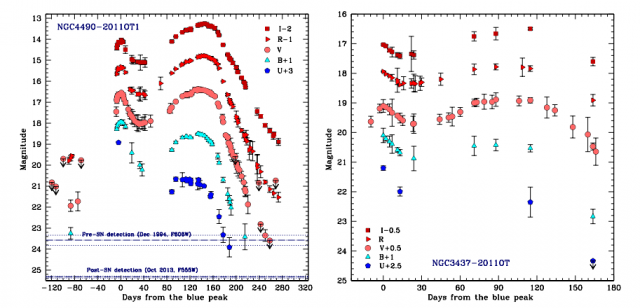
-
AuthorPosts
- You must be logged in to reply to this topic.
